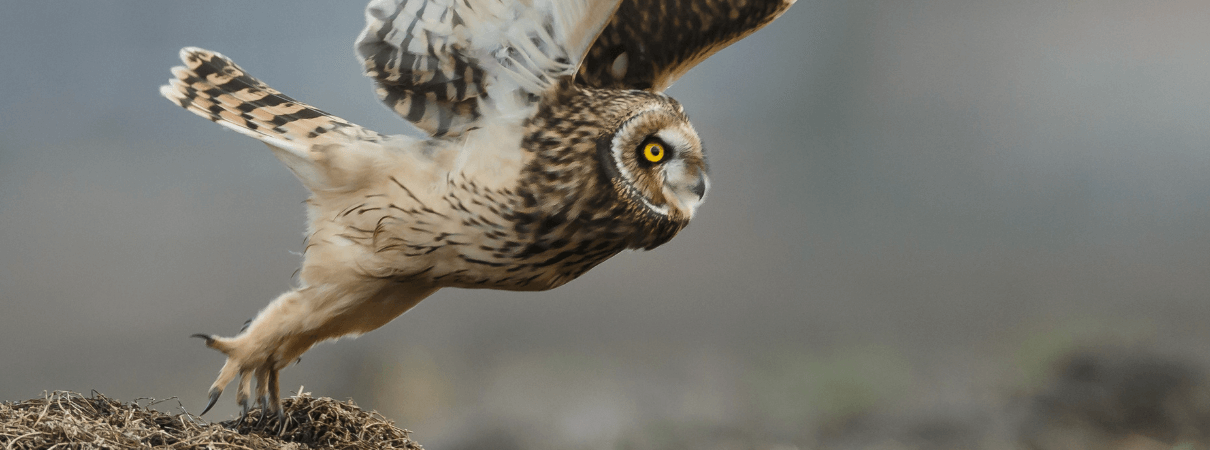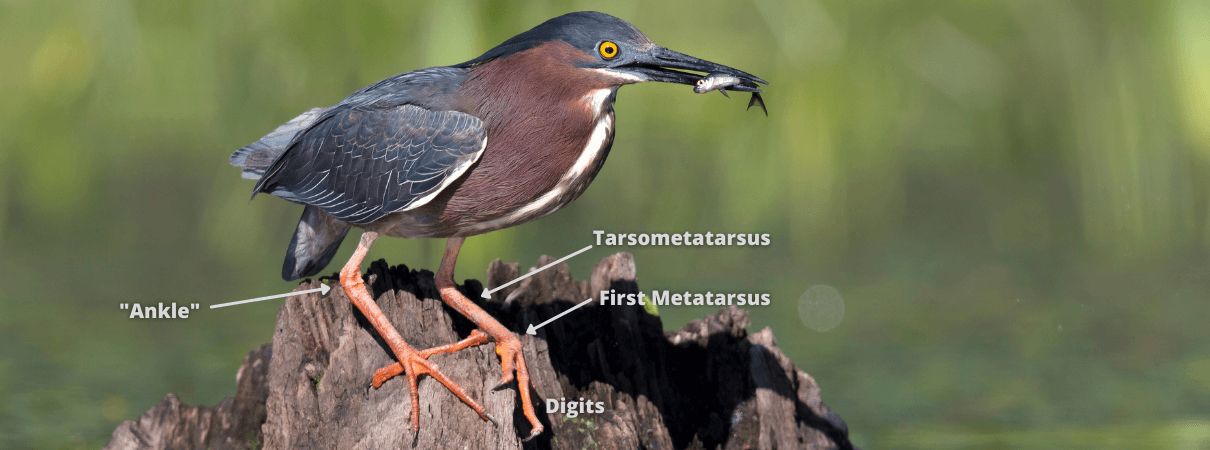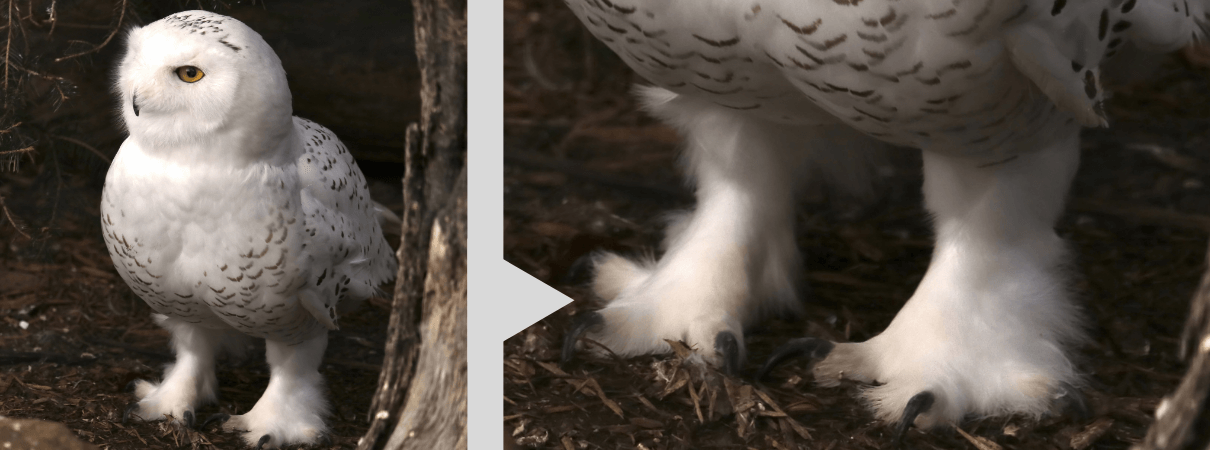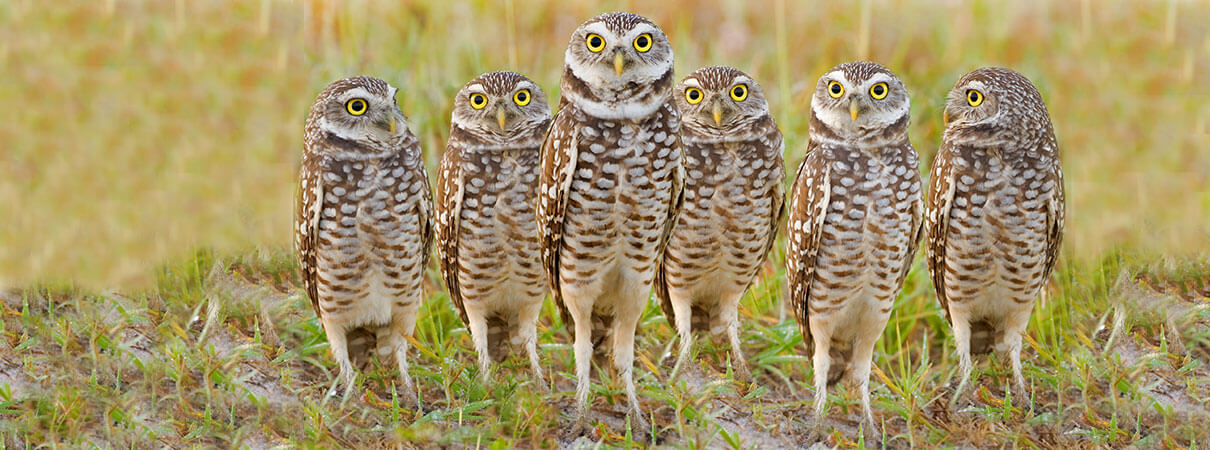Why Are Owl Legs So Long? The Science Behind Those Lengthy Bird Limbs
Have you seen pictures showing how long owl legs are? Owls, it turns out, are much “leggier” than we might guess. In fact, seeing pictures of an owl's spindly limbs can be bit of a shock.
What's going on here? Why do owls have such long legs, and why does this fact feel like such a surprise?

Short-eared Owl. Photo by Menno Schaefer/Shutterstock
Standing on their toes
The first thing to consider is that nearly all bird legs are longer than they look at first glance.
Bird legs have the same general components that ours do: toes, feet, ankles, shins, knees, and thighs. But the relative proportions of each of these are very different.
When you look at a bird (the heron below, for example), the main backwards-facing joint that you see toward the middle of its leg is actually the ankle. The lower half of the visible leg, below the ankle, is its foot. Rather than having multiple small bones in the middle of the foot like we do, birds have a single long, slender bone (called a tarsometatarsus, if you want to win trivia points).

Green Heron. Photo by ttp1001/Shutterstock
Above the ankle, making up the upper half of the visible leg, is the bird's shin (or tibiotarsus). Birds have knees, but unlike us, their thighs are short and tucked close to their bodies, so their knees and upper legs are hidden beneath their plumage. As a result, we usually only see the lower two-thirds or half of a bird's legs!
There are good reasons for birds to have this leg structure, which we'll get to in a moment. In the case of owls, the long, fluffy body feathers found on many species mean that owls do a good job of hiding their legs, often showing just the tips of their toes.
(For the artists out there: Taking this anatomy into account may help with knowing how to place those legs on your bird drawings!)
Thin legs are good for…flying?
Owl legs are long, but perhaps even more surprising is how thin they are. Compared to the rest of the animal, an owl's legs can look extraordinarily slim and delicate! This, along with short thighs and long feet, are primarily adaptations for a single purpose: flight.

Barn Owl. Photo by Kenneth Rush/Shutterstock
Flying is all about weight distribution and specifically about keeping weight centralized and balanced. (Imagine, for instance, how difficult it would be to balance an airplane that had heavy wing tips.) One way that birds accomplish weight centralization is by keeping the large muscles of the upper legs relatively compact and close to the body, while the outer extremities are light, bony, and controlled by stringy tendons.
While birds in general have long, thin legs, there is a lot of variation (this versus this, for example). And these differences can often tell us something about what a bird does, and about its natural history in general.
These legs are made for killing
While they may look cute, owls are vicious predators (see video below, if you need proof) Owls hunt everything from rodents and other small mammals to birds, reptiles, amphibians, large moths, and even fish. And their legs and feet are the tools that they use to catch and kill their food. This is usually done by grabbing prey in their talons and constricting or stabbing it to death. Occasionally, additional blows are delivered using the beak. (Yikes. It's not hard to imagine how this plays out from a mouse or vole's perspective.)
This feet-first hunting strategy is similar to that used by hawks and eagles, and notably different from species like herons or kingfishers, which use a head-first strategy and grab prey with their bills.
Subduing prey with their feet has the important benefit of keeping owls' heads and eyes safely out of harm's way. A single kick or scratch to the eye from flailing prey could be disastrous for a hunter that relies so heavily on its acute vision.
When it comes to owl legs, long and thin does not mean delicate: Owl legs and talons can be extremely strong. If you watched the owl attack above, you already have an idea of the type of prey an owl can carry off. Leading feet first, it is claimed that a Great Gray Owl can punch through a crust of snow strong enough to support the weight of a 176-pound person. Not bad for a bird that only weighs around three pounds, or about as much as your laptop computer!
Cold extremities
There is one more thing to consider when it comes to owls that live in colder environments. The unique structure of their legs helps them to survive in low temperatures: With the main muscles situated close to the body and the lower parts of the legs mostly made of bone and tendon, these birds can allow their feet to get much colder than the rest of their body without losing function or getting frostbite.
For owls that live in these environments, like the Great Gray Owl or the Snowy Owl, feathering on the legs themselves, as well as long, dense feathers on the bird's belly, also helps to maintain warmth.

Snowy Owl legs. Photo by Sharon Feragotti/Shutterstock
Great Gray Owls take this fluffy insulation to an extreme. Their feathers act like a giant down sleeping bag, obscuring the birds' true shape and size, while exposing only their eyes and the tips of their toes. And those toe tips can get very cold without bothering the owl! While Great Grays are the biggest owls in the world by height, they weigh substantially less than species like the Great Horned Owl, which averages 25 percent shorter.
For us, this heavy insulation makes the actual length of a Great Gray's legs even more unexpected when we have a chance to see them.
But why do I keep looking at these owl pictures?
So, from the purely technical side of things, owls have long legs because it's a vital part of their hunting strategy. Plus, those legs look particularly long because they are so thin, a feature of all birds that helps centralize weight away from their extremities. And, especially for owls that live in cold climates, their legs are often hidden by fluffy body feathers, meaning that we rarely get to see just how long their legs really are. But all these details still don't quite seem to explain the appeal photos like these.
The reason for that, at least in part, may be from the way that these awkward images upend our usual ideas about owls.
Maybe it's their nocturnal habits or those large, forward-facing eyes that seem strangely similar to our own, but whatever the reason, there is something about owls that captures our attention. Interest in these predators appears again and again across cultures and history. On the walls of France's Chauvet Cave, prehistoric artists outlined the unmistakable image of an owl around 30,000 years ago. In Ancient Greece, owls were symbols of wisdom, a companion to the goddess Athena. For the Navajo, owls are more ominous, traditionally seen as bearers of bad news and associated with death. In pop culture, owls feature prominently as everything from the messengers of Harry Potter to company logos.

Burrowing Owls. Photo by Tania Thompson/Shutterstock
Whether they are as emblems of wisdom or messengers of bad news, owls usually seem to be serious characters in our mythologies. Reverence is definitely something I feel whenever I'm lucky enough to see one. “Look, an owl!” is almost always accompanied by hushed tones and a murmur of quiet appreciation. And for me, the human-like expressions of the owls and the way these pictures upend our reverential associations are part of the fun of the long-legged owl photos.
 |
John C. Mittermeier is the Director of Threatened Species Outreach at ABC. He works with ABC's partners in Bolivia and helps to lead ABC's lost birds and bird trade initiatives. You can contact him via twitter @johnmittermeier. |


















































